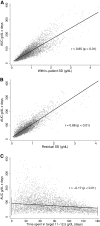Hemoglobin variability does not predict mortality in European hemodialysis patients
- PMID: 20798262
- PMCID: PMC3013534
- DOI: 10.1681/ASN.2009101017
Hemoglobin variability does not predict mortality in European hemodialysis patients
Abstract
Patients with CKD exhibit significant within-patient hemoglobin (Hb) level variability, especially with the use of erythropoiesis stimulating agents (ESAs) and iron. Analyses of dialysis cohorts in the United States produced conflicting results regarding the association of Hb variability with patient outcomes. Here, we determined Hb variability in 5037 European hemodialysis (HD) patients treated over 2 years to identify predictors of high variability and to evaluate its association with all-cause and cardiovascular disease (CVD) mortality. We assessed Hb variability with various methods using SD, residual SD, time-in-target (11.0 to 12.5 g/dl), fluctuation across thresholds, and area under the curve (AUC). Hb variability was significantly greater among incident patients than prevalent patients. Compared with previously described cohorts in the United States, residual SD was similar but fluctuations above target were less frequent. Using logistic regression, age, body mass index, CVD history, dialysis vintage, serum albumin, Hb, angiotensin-converting enzyme (ACE) inhibitor or angiotensin receptor blocker (ARB) use, ESA use, dialysis access type, dialysis access change, and hospitalizations were significant predictors of high variability. Multivariable adjusted Cox regression showed that SD, residual SD, time-in-target, and AUC did not predict all-cause or CVD mortality during a median follow-up of 12.4 months (IQR: 7.7 to 17.4). However, patients with consistently low levels of Hb (<11 g/dl) and those who fluctuated between the target range and <11 g/dl had increased risks for death (RR 2.34; 95% CI: 1.24 to 4.41 and RR 1.74; 95% CI: 1.00 to 3.04, respectively). In conclusion, although Hb variability is common in European HD patients, it does not independently predict mortality.
Figures




References
-
- Besarab A, Bolton WK, Browne JK, Egrie JC, Nissenson AR, Okamoto DM, Schwab SJ, Goodkin DA: The effects of normal as compared with low hematocrit values in patients with cardiac disease who are receiving hemodialysis and epoetin. N Engl J Med 339: 584–590, 1998 - PubMed
-
- Singh AK, Szczech L, Tang KL, Barnhart H, Sapp S, Wolfson M, Reddan D: Correction of anemia with epoetin alfa in chronic kidney disease. N Engl J Med 355: 2085–2098, 2006 - PubMed
-
- Drueke TB, Locatelli F, Clyne N, Eckardt KU, Macdougall IC, Tsakiris D, Burger HU, Scherhag A: Normalization of hemoglobin level in patients with chronic kidney disease and anemia. N Engl J Med 355: 2071–2084, 2006 - PubMed
-
- Pfeffer MA, Burdmann EA, Chen CY, Cooper ME, de Zeeuw D, Eckardt KU, Feyzi JM, Ivanovich P, Kewalramani R, Levey AS, Lewis EF, McGill JB, McMurray JJ, Parfrey P, Parving HH, Remuzzi G, Singh AK, Solomon SD, Toto R; TREAT Investigators: A trial of darbepoetin alfa in type 2 diabetes and chronic kidney disease. N Engl J Med 361: 2019–2032, 2009 - PubMed
-
- Arneson TJ, Zaun D, Peng Y, Solid CA, Dunning S, Gilbertson DT: Comparison of methodologies to characterize haemoglobin variability in the US Medicare haemodialysis population. Nephrol Dial Transplant 24: 1378–1383, 2009 - PubMed
Publication types
MeSH terms
Substances
LinkOut - more resources
Full Text Sources
Medical
Miscellaneous

